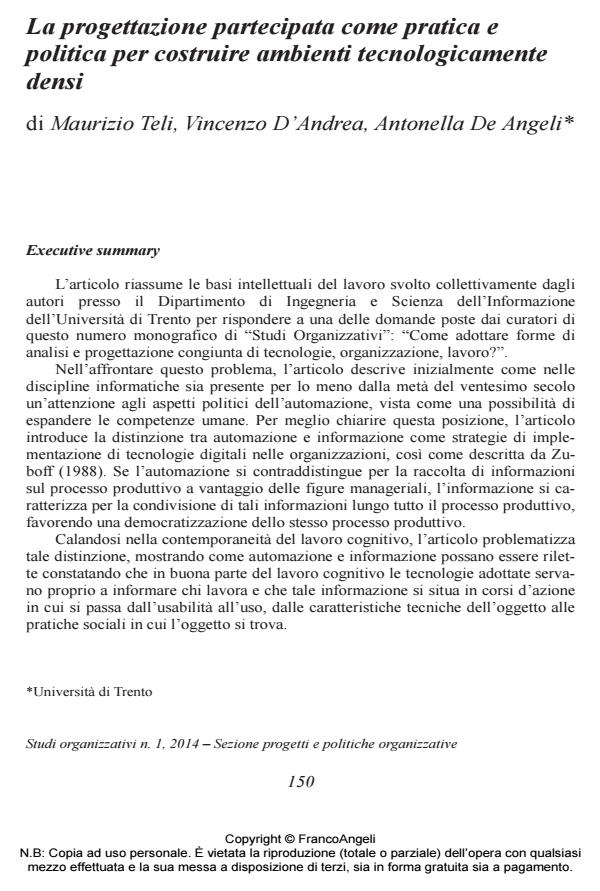La progettazione partecipata come pratica e politica per costruire ambienti tecnologicamente densi
Journal title STUDI ORGANIZZATIVI
Author/s Maurizio Teli, Vincenzo D'Andrea, Antonella De Angeli
Publishing Year 2014 Issue 2014/1 Language Italian
Pages 13 P. 150-162 File size 61 KB
DOI 10.3280/SO2014-001007
DOI is like a bar code for intellectual property: to have more infomation
click here
Below, you can see the article first page
If you want to buy this article in PDF format, you can do it, following the instructions to buy download credits

FrancoAngeli is member of Publishers International Linking Association, Inc (PILA), a not-for-profit association which run the CrossRef service enabling links to and from online scholarly content.
Starting with Wiener’s political program in the field of informatics, oriented toward enhancing human capabilities, this paper sketches the research agenda of the authors as designers of digital technologies. Drawing upon Zuboff’s analysis of the use of digital technologies in organizations, that distinguish between automating, more hierarchically oriented, and informating, more democratically oriented, the article discuss the concepts in the light of the transformation of the way of working, nicely captured by the focus on knowledge work and on technologically dense environments. In such a context, Scandinavian Participatory Design is introduced, as a way of designing technologies that privileges the situated use value for workers. Through the direct participation of users in the design of technological artefacts, Participatory Design is able to rebalance some of the power relations related to the use of technology. his is shown through the case of the Smart Campus project, that confirms the ability of users participation to reshape power relations. In conclusion, the article defines as future research goals the ones related to the understanding of the potential for users participation in Italy outside the university context.
Keywords: Automation, information, participatory design, university, politics
- Bannon, L. (1991), “From Human Factors to Human Actors: The Role of Psychology and Human-Computer Interaction Studies in System Design”, Design at work: Cooperative design of computer systems, 25-44.
- Berardi, F. (2001), La fabbrica dell’infelicità: new economy e movimento del cognitariato, Roma, DeriveApprodi.
- Bergvall-Kåreborn, B., Ståhlbrost, A. (2008), “Participatory Design: One Step Back or Two Steps Forward?”, in Proceedings of the Tenth Anniversary Conference on Participatory Design.
- Briefs, U., Ciborra, C.U., Schneider, L. (eds.) (1983), “Systems Design For, With, and By the Users”, Proceedings of the Ifip Wg 9.1 Working Conference on Systems Design For, With, and by the Users.
- Bruni, A. (2005), “Shadowing Software and Clinical Records: On the Ethnography of Non-Humans and Heterogeneous Contexts”, Organization, 12(3): 357-378, DOI: 10.1177/1350508405051272
- Bruni, A., Pinch, T., Schubert, C. (2014), “Technologically Dense Environments: What For? What Next?”, Tecnoscienza. Italian Journal of Science & Technology Studies, 4: 51-72.
- Butera, F. (2008), “Chi sono e perché sono tanti i lavoratori della conoscenza: dieci anni di ricerche”, in Butera, F., Bagnara, S., Cesaria, R., Di Guardo, S.
- (a cura di) Knowledge Working. Lavoro, lavoratori, società della conoscenza, Milano, Mondadori Università.
- D’Andrea, V., Teli, M. (2010), “Teaching Participatory Design: A Participatory Approach”, Proceedings of the 11th Biennial Participatory Design Conference.
- Dantec, C.A.L., DiSalvo, C. (2013), “Infrastructuring and the Formation of Publics in Participatory Design”, Social Studies of Science, 43: 241-264. DOI: 10.1177/030631271247158
- De Angeli, A., Lynch, P., Johnson, G.I. (2002), “Pleasure versus Efficiency in User Interfaces: Towards an Involvement Framework”, in Green W., Jordan P. (eds.), Pleasure with products: Beyond usability, CRC Press.
- Ehn, P. (1993), “Scandinavian Design: On Participation and Skill”, in Schuler D., Namioka A. (eds.), Participatory Design: Principles and Practices, CRC Press.
- Ehn, P. (2008), “Participation in Design Things”, Proceedings of the Tenth Anniversary Conference on Participatory Design.
- Ertner, M., Kragelund, A.M., Malmborg, L. (2010), “Five Enunciations of Empowerment in Participatory Design”, Proceedings of the 11th Biennial Participatory Design Conference Gibson, J.J. (1979), The Ecological Approach to Visual Perception, New York, Houghton Mifflin.
- Latour, B. (2004), “Why Has Critique Run out of Steam? From Matters of Fact to Matters of Concern”, Critical Inquiry, 30: 225-248. DOI: 10.1086/CI.2004.30.ISSUE-2
- Marglin, S.A. (1996), “What Do Bosses Do?”, Review of Radical Political Economics, 6: 60-112.
- Medina, E. (2011), Cybernetic Revolutionaries, Cambridge, MA: MIT Press.
- Menendez, M., Bordin, S., De Angeli, A. (2014), “Mediating divergent perspectives: new responsibilities for interaction desig”, manoscritto non pubblicato.
- Negri, A., Vercellone, C. (2007), “Il rapporto capitale/lavoro nel capitalismo cognitivo”, Posse.
- Pipek, V., Wulf, V. (2009), “Infrastructuring: Toward an Integrated Perspective on the Design and Use of Information Technology”, Journal of the Association for Information Systems, 10: 447-473.
- Wiener, N. (1950), The Human Use of Human Beings: Cybernetics and Society, Da Capo Press.
- Zuboff, S. (1988), In the Age of the Smart Machine: The Future of Work and Power, Basic Books.
- Perceived autonomy and discretion of mobile workers Roberto Albano, Ylenia Curzi, Tania Parisi, Lia Tirabeni, in STUDI ORGANIZZATIVI 2/2019 pp.31
DOI: 10.3280/SO2018-002002 - Assessing the technological maturity of small enterprises through a collaborative approach Andrea Tomo, in STUDI ORGANIZZATIVI 2/2019 pp.147
DOI: 10.3280/SO2018-002007
Maurizio Teli, Vincenzo D'Andrea, Antonella De Angeli, La progettazione partecipata come pratica e politica per costruire ambienti tecnologicamente densi in "STUDI ORGANIZZATIVI " 1/2014, pp 150-162, DOI: 10.3280/SO2014-001007